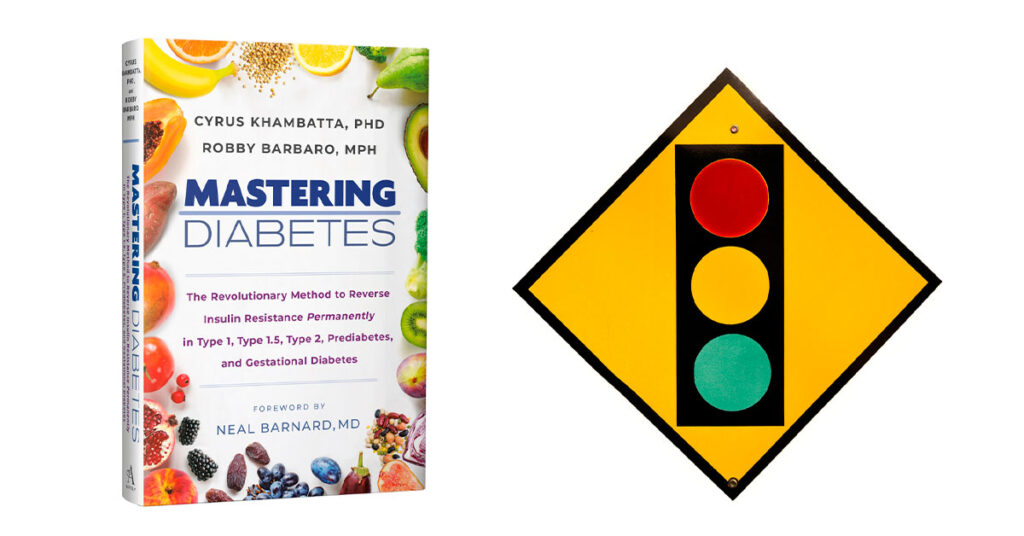

The following is an excerpt from MASTERING DIABETES (2020, Avery, a member of Penguin Group (USA) LLC) by Cyrus Khambatta, PhD & Robby Barbaro, MPH, foreword By Neal Barnard, MD.
As we’ve learned firsthand— and as we’ve witnessed thousands of times with our clients— the food you eat is the single most important variable when it comes to reversing insulin resistance. If you are nervous about changing your diet or concerned that eating more carbohydrate-rich food will increase your blood glucose values, don’t worry. We don’t recommend making sudden, drastic changes. This method is designed to help you ease into this lifestyle step by step, monitoring how your blood glucose responds along the way.
The good news is that once you start to build your meals around green light foods, you are likely to become nutritionally satisfied, and cravings for processed foods will likely fade away.
To make your transition to a low-fat plant-based whole-food diet as straightforward as possible, we created a three-part system to help you easily identify which foods to eat in abundance, which foods to minimize, and which foods to eliminate altogether. As for what to eat, it’s a simple, easy-to-follow green light, yellow light, red light system.
Examples of Green Light Foods:
Perhaps the most important aspect of the Mastering Diabetes Method is that carbohydrate-rich foods are easy to metabolize when your total fat intake is kept low (especially saturated fat). In fact, unless you are injecting fast-acting insulin, when you eat a low-fat plant-based whole-food diet, it’s not necessary to micromanage your carbohydrate intake. When you’re consistently eating a maximum of 15 percent of your total calories as fat, your body’s ability to metabolize whole carbohydrate-rich foods will increase over time, allowing you to eat larger quantities of carbohydrate-rich foods while maintaining excellent blood glucose control.
The foods in the green light category are to be eaten ad libitum, which means that you can eat as much of these foods as you want. Collectively, green light foods are the most nutrient-dense foods on the planet, complete with all three macronutrients, as well as vitamins, minerals, fiber, water, antioxidants, and phytochemicals. Green light foods are fiber-rich and contain between 60 and 90 percent water, which means that when they make up the bulk of your meal, they will make you mechanically full and nutritionally full before you become calorically full. This means that when your stomach begins to distend, it will send a neurological impulse to your brain that says “Slow down!” or “Stop eating!” Your brain responds by curbing your appetite, which decreases the number of calories you eat while remaining satisfied. Green light foods contain only a fraction of the calorie density of red light and yellow light foods, meaning that you won’t even have to think about overconsuming calories.
Examples of Yellow Light Foods:
The foods listed in the yellow light category are plant-based foods that can certainly be part of your diet in small amounts. Avocados, nuts, seeds, olives, coconut meat, and soy products are all whole foods high in fat, and even though they contain predominantly unsaturated fat, when eaten in large quantities they, too, can cause insulin resistance and high blood glucose. Substituting foods containing unsaturated fat for foods high in saturated fat and trans fat dramatically improves your insulin sensitivity within weeks. That said, it’s still very important to be mindful of your total fat intake, even if the majority of your fat comes from unsaturated sources. This will ensure that your liver and muscles have the greatest chance of maximizing their sensitivity to insulin.
Non-wheat pasta alternatives, such as products made from lentils, quinoa, beans, and brown rice, are also in the yellow light category because they are often highly processed, and we advocate eating foods in their most intact whole form whenever possible. Conventional pastas are made from wheat and require many processing steps before making it into the package that you recognize at the grocery store, including grinding, sifting, extruding, and drying. At each step in the process, the micronutrients originally present in the wheat are lost, resulting in a micronutrient-depleted end product that is low in nutrient density.
As a result, many companies now make pasta alternatives using non-wheat sources including chickpeas, quinoa, black beans, mung beans, soybeans, brown rice, and lentils. While these pasta alternatives generally have a higher nutrient density than conventional pastas, they are still more processed than the intact food from which they originated. As a general rule of thumb, when choosing between two foods like brown rice and brown rice pasta, choose the brown rice because it requires less processing and has a higher micronutrient content than the brown rice pasta.
Examples of Red Light Foods:
The red light category includes two main groups of foods: animal products and processed foods. As we’ve discussed earlier, red light foods increase your risk of chronic diseases and hinder glucose absorption into tissues. We’ve also included oil in this category because oil is the most refined and calorie-dense food in the grocery store. Some oils contain trace amounts of vitamins and minerals, but oils are devoid of carbohydrate, protein, fiber, and water, and the vast majority of vitamins, minerals, antioxidants, and phytochemicals have been removed in the extraction process. So what you’re left with is the single most calorie-dense food in existence, containing minimal micronutrient value.
The good news is that once you start to build your meals around green light foods, you are likely to become nutritionally satisfied, and cravings for processed foods will likely fade away. Countless clients have told us how satisfied they are eating green light foods, and how much they enjoy eating large quantities of fruits and starchy vegetables, guilt-free.
Adapted from MASTERING DIABETES by arrangement with Avery, a member of Penguin Group (USA) LLC, A Penguin Random House Company. Copyright © 2020, Cyrus Khambatta and Robby Barbaro.
Copyright 2024 Center for Nutrition Studies. All rights reserved.